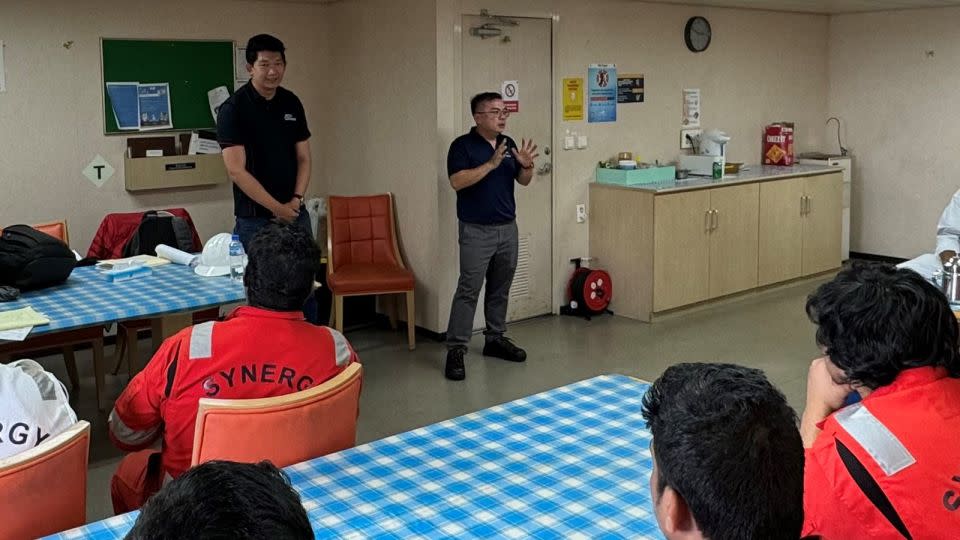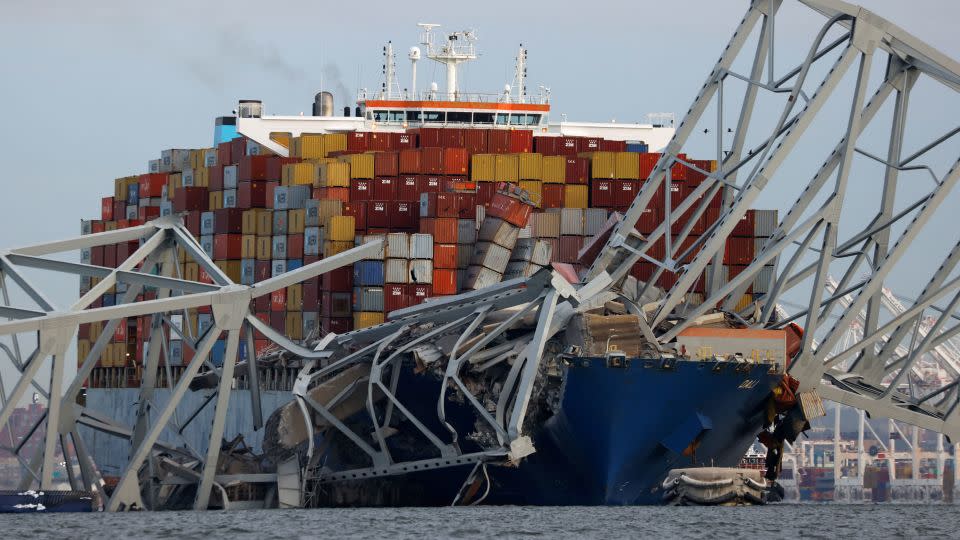They’ve been stuck for 7 weeks on the ship that crashed into a Baltimore bridge. This is what life is like for the Dali crew
When the Rev. Mark Nestlehutt boarded the Dali cargo ship a week after it crashed into a Baltimore bridge, anxious questions emerged among the 21 crew members:
“When will I get off the ship? When will I be able to get home?”
More than a month later, crew members still don’t know the answers.
They’ve been confined to the ill-fated Dali ever since it lost power, veered off course and crushed the Francis Scott Key Bridge on March 26, killing six construction workers.
Since then, the 20 Indians and one Sri Lankan on board have mourned the deaths of those lives lost, had their cell phones confiscated by the FBI and endured a series of controlled explosions to break apart a massive piece of bridge stuck atop the ship’s bow.
“It has been tough for the seafarers, primarily (because) they know that there’s been loss of life,” said Gwee Guo Duan, assistant general secretary of the Singapore Maritime Officers’ Union, one of the unions representing crew members on the Singaporean-flagged ship.
“It is tough for them, being on board and having to look at the accident site every single day.”
But it could be weeks or even months before they can leave, due to an array of complications – including US visas that expired while they’ve been trapped. Here’s why they’re still stuck on board – and how they’re coping with unimaginable stressors:
Maritime rules say the ship must be staffed
A massive vessel like the 984-foot, 106,000-ton Dali requires constant care – even if it’s not moving. And a ship stuck on a river still faces a host of potential hazards, said Philip C. Schifflin Jr., director of the Center for Mariner Advocacy.
“You can take on water. There’s machinery running … anytime machinery is running, there’s a particular risk of something failing and causing a fire or something like that,” Schifflin said. “So seafarers need to be on board ready to respond to those various hazards. And that’s by law.”
The United States has “minimum requirements for the manning of vessels,” according to the Office of the Federal Register, and similar international regulations have been widely adopted.
“By international maritime regulations, there has to be some crew left on the vessel,” said Nestlehutt, president and executive director of The Seamen’s Church Institute, which promotes the safety and welfare of mariners.
The nonprofit responds to seamen in distress around the world, including those afflicted by hurricanes, pirate incidents or deaths at sea.
When Nestlehutt visited the Dali crew on April 1, he immediately noticed their “sense of great loss and sadness” about the construction workers killed, and the seamen “wanted to let their own family members know that they were safe,” he said.
But days later, the crew lost contact with their families when the FBI seized the crew’s cell phones on April 15 as part of its ongoing investigation into the crash.
‘Unfounded fear’ among the crew members
After the FBI boarded the Dali and seized the seamen’s cell phones, a wave of anxiety permeated the ship, according to a joint statement from the Singapore Maritime Officers’ Union, which represents the ship’s officers, and the Singapore Organisation of Seamen, which represents the other crew members.
The seafarers have since received new cell phones, Duan told CNN Thursday. But the FBI has only returned some of the crew members’ SIM cards, he said.
Although investigators have not blamed any individual for the power outages that led up to the fatal crash, seamen have felt an “Unfounded fear of personal criminal liability,” the two unions representing the crew members said.
“However long the investigation takes, the crew’s rights and welfare should not be infringed upon during its course,” Dave Heindel, president of the Seafarers International Union, said in a statement.
“We call on the authorities to be mindful that seafarers utilize mobile devices to conduct personal business for bill payments and more importantly, transfer money to their home country to sustain families,” he said. “Crew members are becoming demoralized without the basic tools we all take for granted.”

“The prolonged detention of MV Dali seafarers aboard their vessel and the failure by authorities to return their personal communication devices are unjust,” Don Marcus, president of the International Organization of Masters, Mates & Pilots, said in a statement.
“Our hearts go out to the Master, Officers and Crew of the M/V Dali, who not only suffered a mortifying and tragic experience resulting in the loss of six lives, but who continue to remain in isolation from their loved ones.”
Stationary, but not sedentary
While they await news about their fates, the crew members are staying busy – not just with their ship duties but also by helping investigators and salvage crews.
“Obviously, this is not a normal environment for them. But they’re all professional seafarers, so they’re doing what they need to do,” said Darrell Wilson, spokesperson for Synergy Marine Group – the company that manages the Dali.
“Their days are full. They have normal duties on board. They need to look after the ship, look after equipment, make sure everything is working and functioning that needs to. They’re also assisting with the salvors.”

The seafarers play a critical role in helping the salvage crews because “they know all the passageways. They know where everything is on the ship,” Wilson said.
“So if somebody has a question about where can we hook up to get running water,” the seafarers can help, Wilson said. “The crew is essentially just assisting in any way possible.”
As for who’s helping the crew members with food, toiletries and other day-to-day necessities, Synergy Marine “dispatched reps here immediately … making sure they have everything they need, helping bring extra supplies on board or arranging for extra supplies to be brought on board,” Wilson said.
In addition, “they have coordinated to have visits by some of the seafarers’ organizations. Some of the seafarers’ ministries have been on. The two respective embassies have been in contact with the crew and even made a visit to the ship,” he said.
Synergy has also provided mental health services for the crew, which Duan – the Singapore Maritime Officers’ Union official – credits for helping a seaman who was traumatized after he frantically tried to search for survivors the night of the deadly crash.
“One of them actually ran to the front of the vessel, which is the bow, to actually try to look for survivors from the accident” – despite the heaps of debris from the bridge that could fall at any moment, Duan said.
On May 13, after six weeks atop the bow of the Dali, a massive piece of the Key Bridge was blown apart in a series of controlled explosions – with the crew still on board.
Many hoped the removal would mean the crew might be able to set sail or at least get off the ship soon. But more hurdles loom.
Their visas expired while they’ve been stuck
In addition to the staffing regulations, the ongoing investigations and questions about whether the Dali is fit to sail, the crew members can’t even set foot on US soil. Their one-month visas expired during the nearly two months they’ve been trapped on the Dali, Duan said.
Even the ship’s management company doesn’t know when the crew can leave.
“They’re going to be on for the foreseeable future,” Wilson told CNN Wednesday. “We’re working to refloat the vessel in a few days and move it to a local terminal here. And then at some point in the future – and I don’t have that date – the company will look for guidance from the authorities on the next steps with the crew.”
Duan, who visited the crew April 24 and communicates with the captain regularly, said he doesn’t expect the ship to leave the Baltimore area until authorities have completed their investigation.
The National Transportation Safety Board’s preliminary report about the crash did not include a probable cause, which will be part of a final report that could take investigators up to two years to complete.
“Without the final report, I don’t think the vessel is going anywhere” far from Baltimore, Duan said.
On Monday, several tugboats towed the vessel to the Port of Baltimore’s Seagirt Marine Terminal – the same spot the Dali departed from on its ill-fated voyage almost eight weeks ago. There, the ship will undergo any necessary, temporary fixes before more permanent repairs can be made, officials have said.
In the meantime, Duan hopes nonessential crew members will be allowed to get off the ship and stay temporarily on dry land to “ease their mental stress.”
The crew members’ unions have publicly called for the extension or renewal of the seamen’s visas. Duan also hopes US authorities will re-evaluate who must stay on the ship, and who might be able to fly home.
‘We take their sacrifices for granted’
The plight of the Dali’s crew highlights the personal sacrifices made by workers who often leave their families for months at a time to provide goods that many consumers use every day.
“I think most of us think of the items that we use on a daily basis show up on Amazon or … Walmart, etc. The reality is 90% of the cargo in the world is carried on vessels,” said Schifflin, the director of the Center for Mariner Advocacy.
“Vessels are manned by seafarers. And to most of us – the vast majority of us – they’re invisible. We don’t even know they’re there. And I think a lot of times, we take their sacrifices for granted.”
CNN’s Gloria Pazmino contributed to this report.
For more CNN news and newsletters create an account at CNN.com

